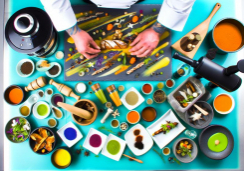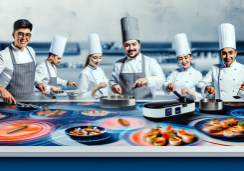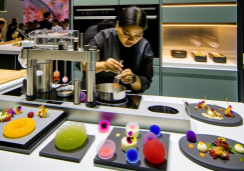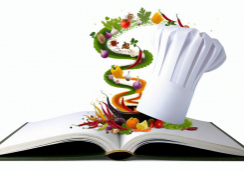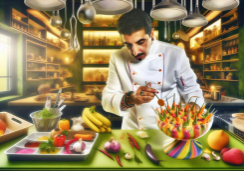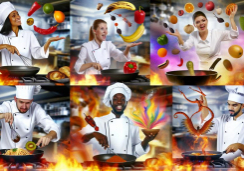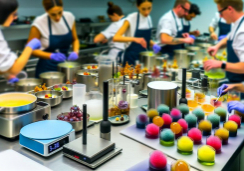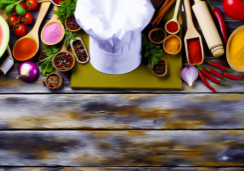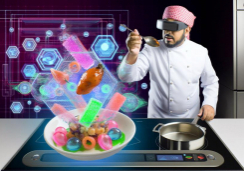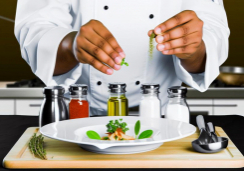What Are the Latest Culinary Techniques for Creativity?
As a chef in the modern culinary arena, you're no stranger to the dance of flames and flavor, where innovation meets tradition in a tantalizing tango. You've seen how sous vide mastery can transform the texture of proteins, how the art of spherification can encapsulate an ocean of taste in a single bite, and how emulsification techniques can marry oil and vinegar in a harmonious union that once seemed impossible.
The adventures in foam expand your repertoire, adding airy whispers of taste to your plates, while the cool magic of liquid nitrogen creates culinary spectacles that dazzle the senses. Yet, there's a whisper of new techniques just beyond the horizon, a promise of unexplored territories in the culinary landscape.
You stand at the precipice, where your next step could redefine the boundaries of culinary artistry, but what lies ahead? Will you harness these emerging methods to elevate your creations to the next level?
Sous Vide Mastery
Embrace the precision of sous vide Mastery, where vacuum-sealing your culinary creations and immersing them in a temperature-controlled water bath unlocks unparalleled flavors and textures. This scientific method of cooking food in vacuum-sealed bags offers you a level of control that traditional cooking techniques simply can't match.
With sous vide, you're not just cooking; you're orchestrating a culinary symphony where time and temperature play the lead roles. The water bath's consistent temperature ensures that your food reaches the exact level of doneness you desire, every single time. This is precision you can taste. Tender, juicy steaks, succulent vegetables, and delicate seafood emerge with their natural flavors and nutrients remarkably intact, thanks to this low and slow process.
Moreover, this technique isn't just for proteins. Imagine infusing oils or syrups with herbs or citrus, creating consistent foams and sauces, or even concocting new types of soft candies. The possibilities are virtually endless.
Venture beyond the traditional and elevate your cooking repertoire with sous vide Mastery. Immerse yourself in the innovative world of cooking food in vacuum-sealed bags, and let the texture and flavor of your dishes astound every palate.
Art of Spherification
While mastering sous vide unlocks flavors with precision, spherification invites you to transform liquids into mesmerizing spheres, elevating the visual artistry of your dishes. This technique, a gem of molecular gastronomy, relies on the science behind sodium alginate and calcium chloride or lactate to create unique culinary experiences. Spherification isn't just about aesthetics; it's a deliberate play of textures and flavors that can enhance your food pairing prowess.
You'll find two main methods: basic and reverse spherification. The former encapsulates your chosen liquid in a fragile gel, while the latter creates a sturdier sphere, suitable for liquids with high calcium content or alcohol. Getting the proportions right, as well as mastering the timing and technique, is key to achieving the perfect spherification.
Fortunately, modern spherification kits have demystified the process, making it accessible for you to experiment with. Imagine creating spheres that burst in the mouth, releasing a symphony of flavors, or mimicking egg yolks to surprise and delight your guests. By incorporating spherification into your culinary repertoire, you're not just cooking; you're crafting an experience that's as memorable as it's delicious.
Emulsification Techniques
Dive into the world of emulsification techniques, where chefs wield the power to blend oil and water into culinary harmony, crafting sauces and dressings with velvety textures that defy nature's reluctance to mix. As you explore this facet of cooking, you'll discover that common emulsifiers like egg yolks and mustard aren't just for your classic salad dressing; they're the backbone of stable emulsions that elevate an ordinary dish to a work of art.
In your culinary journey, you'll find that whipping is more than a simple flurry of activity; it's a calculated method used to thicken and introduce air, transforming different ingredients into sumptuous foams. The tools and techniques you employ can significantly alter the final texture, offering a playground for innovation.
Embrace the essence of modernist cuisine by exploring new ways to manipulate textures and flavors. Understanding how to harness emulsification techniques is crucial for infusing your dishes with creativity. Whether you're using gelling agents like gelatin or agar-agar to create lasting foams or mastering the delicate balance of an emulsion, your command of these methods will define your culinary signature, setting your creations apart with each refined, delectable spoonful.
How Can Culinary Techniques Enhance Creativity in Cooking?
Mastering culinary creativity techniques for recipes can greatly enhance the overall cooking experience. By learning various methods such as flavor pairing, ingredient substitution, and food presentation, cooks can elevate their dishes to new levels. These techniques encourage experimentation and innovation, leading to more creative and delicious meals.
Adventures in Foam
Venture into the realm of culinary foams, where skillful whipping and sophisticated gelling agents merge to create ethereal textures that tantalize the palate and elevate the dining experience. These techniques aren't just about adding air; they're a form of artistry that turns food into a new sensory delight. By understanding the science of emulsification and the properties of ingredients like gelatin and agar-agar, you can create unique foams that remain stable, enhancing the visual appeal and taste of traditional dishes.
You're not just cooking; you're on an adventure in foam, pushing the boundaries of what's possible in the kitchen. The right tool can make all the difference—immersion blenders, whipping siphons, and even a simple whisk can be your allies in the quest for the perfect foam. Each tool can affect the structure and longevity of your creation, allowing you to innovate and surprise your taste buds with every bite.
Embracing these techniques means embracing change and the future of culinary arts. You're not just preparing a meal; you're crafting an experience. So go ahead, let your culinary adventures in foam begin, and watch as your dishes transform into a symphony of textures that dance across the palate.
Utilizing Liquid Nitrogen
As you master the art of culinary foam, prepare to be equally captivated by the transformative power of liquid nitrogen, a tool that allows chefs to instantly freeze ingredients and astonish the senses with its dramatic effects. This substance, with its ability to create unique textures and visual spectacles, has become a favorite among avant-garde chefs looking to push the boundaries of traditional cooking.
Utilizing liquid nitrogen involves using extreme cold to achieve rapid freezing, resulting in smooth, delicate textures that can't be replicated through conventional methods. Its common use extends to making flash-frozen treats like ice cream and sorbets, where its chilling prowess adds a thrilling element to the dining experience.
Beyond freezing desserts, liquid nitrogen can create unexpected contrasts in savory dishes. Imagine a salad with frozen vinaigrette pearls or a steak topped with a butter that's been flash-frozen into a fine powder—the possibilities for chefs to create are endless.
Innovation in the kitchen doesn't stop with food in vacuum-sealed bags or precision cooking techniques. With liquid nitrogen, your culinary imagination can run wild, crafting experiences that delight and surprise with every bite. Embrace this icy medium, and watch as your creative potential unfurls in a cloud of frosty wonder.
Conclusion
You've explored the frontier of culinary innovation, mastering sous vide for precision, spherification for playful bursts of flavor, and emulsification for silky smooth textures.
Your adventures in foam have added airy elegance to dishes, while liquid nitrogen has unleashed a spectacle of frosty delights.
Keep pushing boundaries; your kitchen is a canvas for creativity, where every technique elevates your artistry.
Stay curious, chef, and continue to transform the ordinary into the extraordinary.

